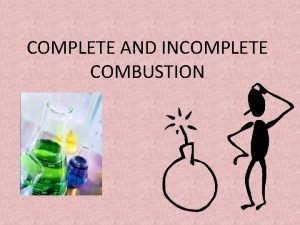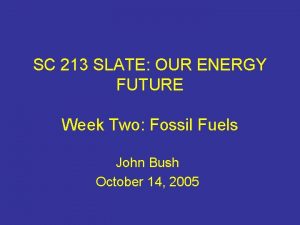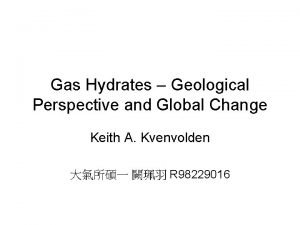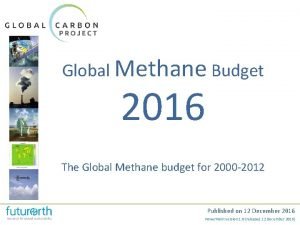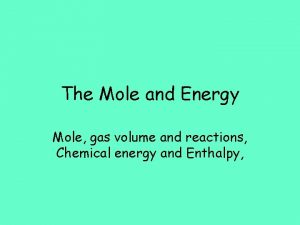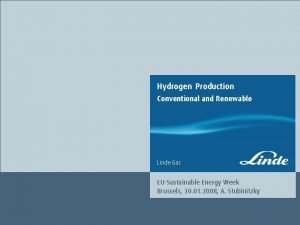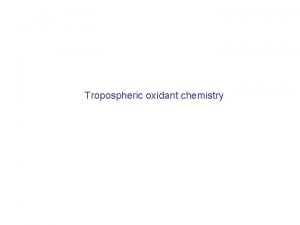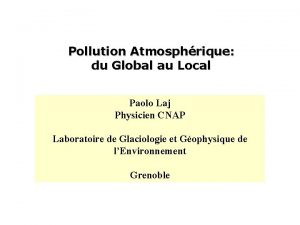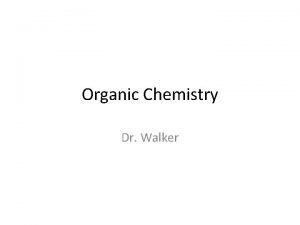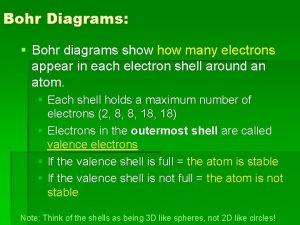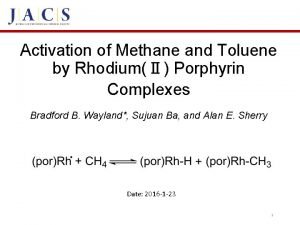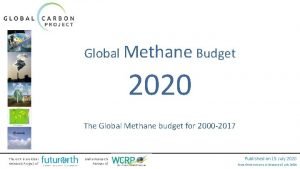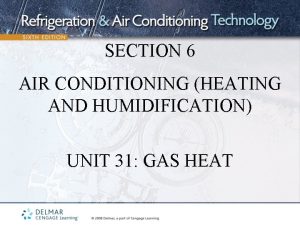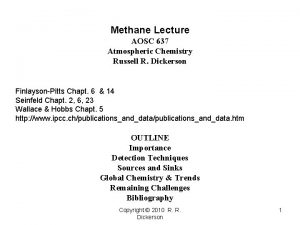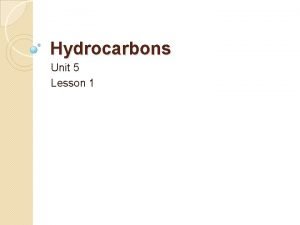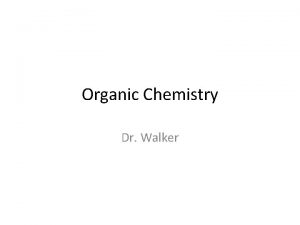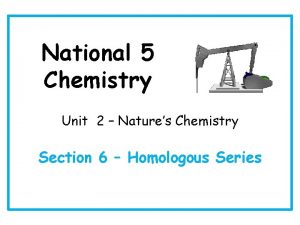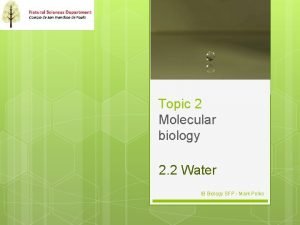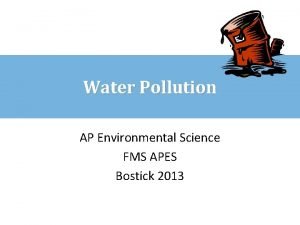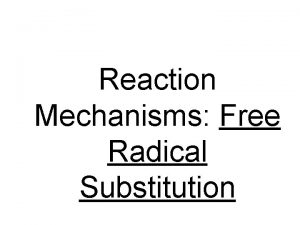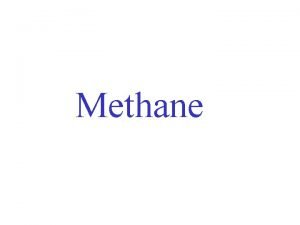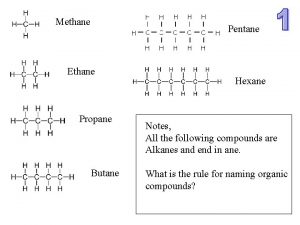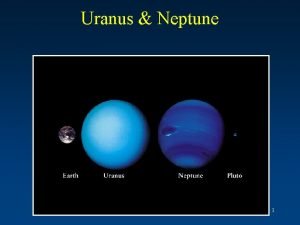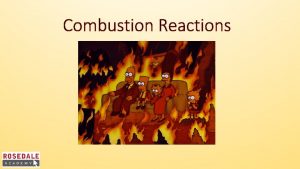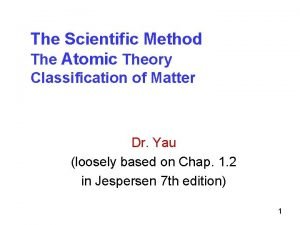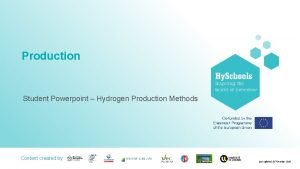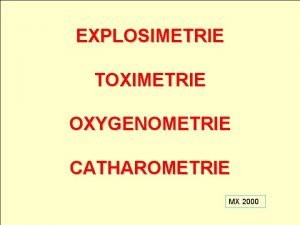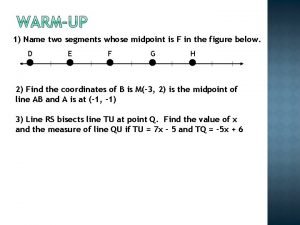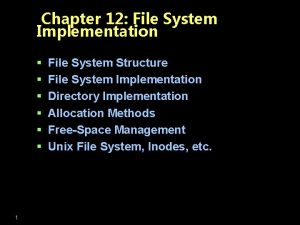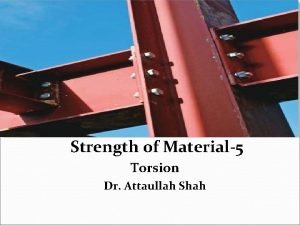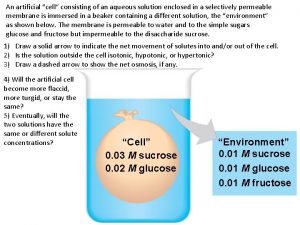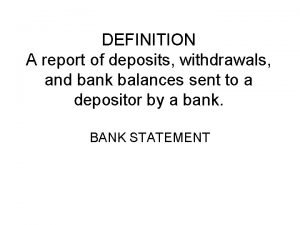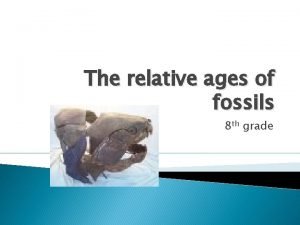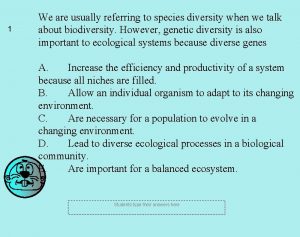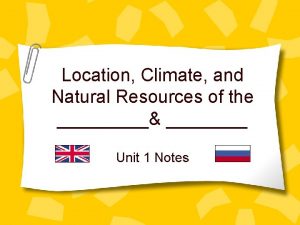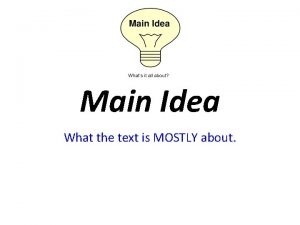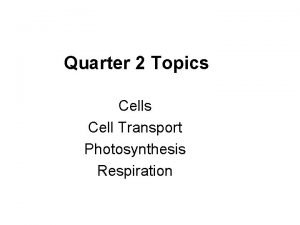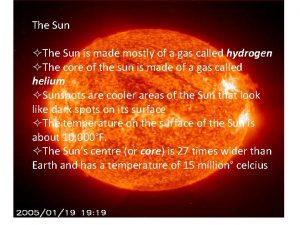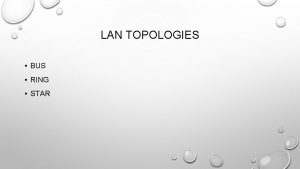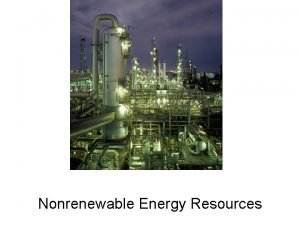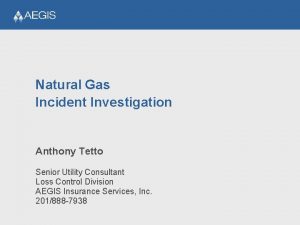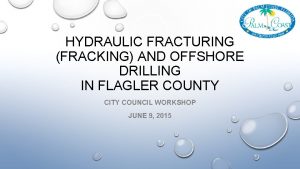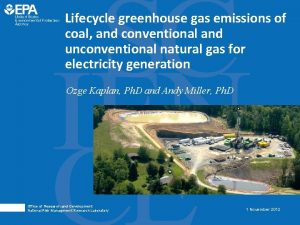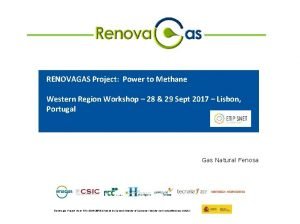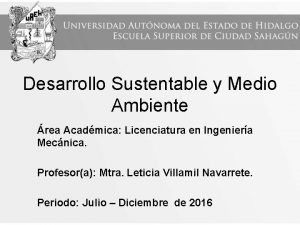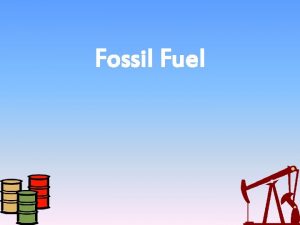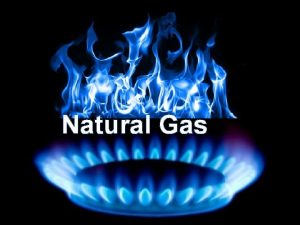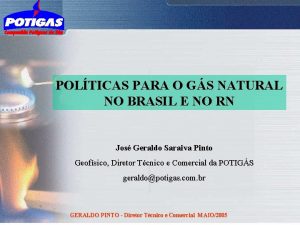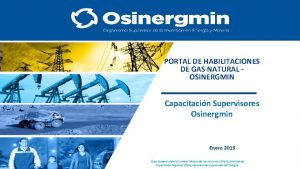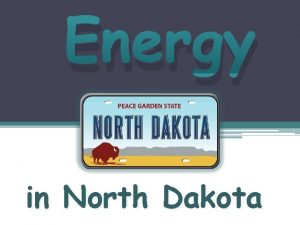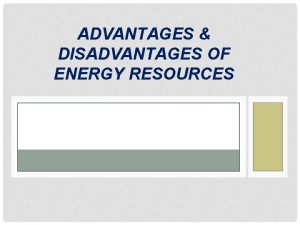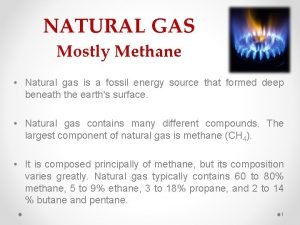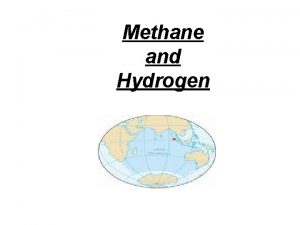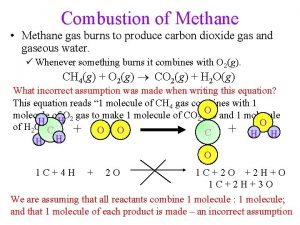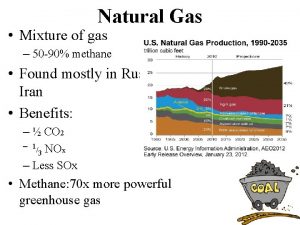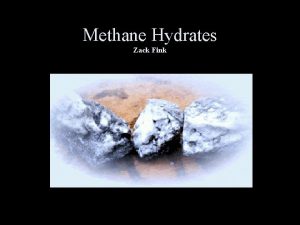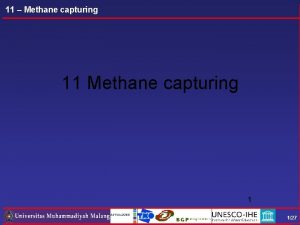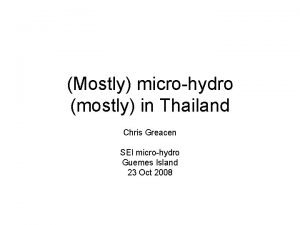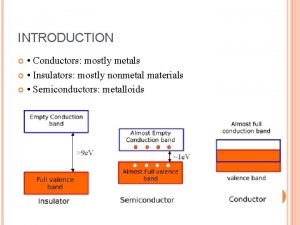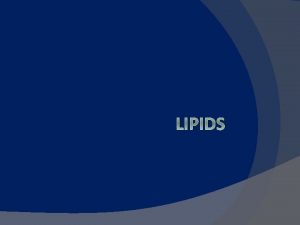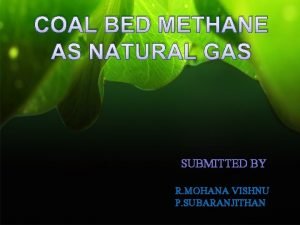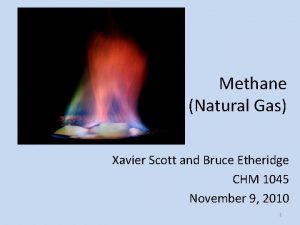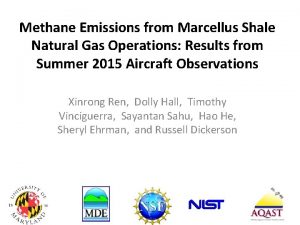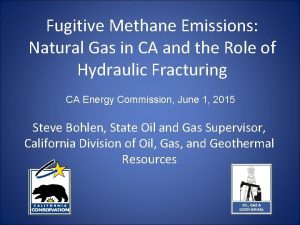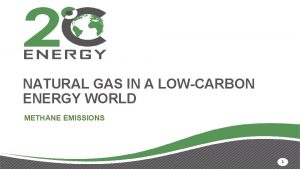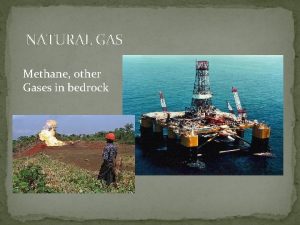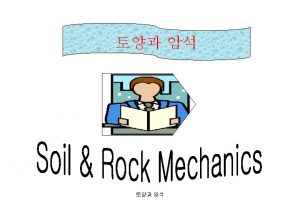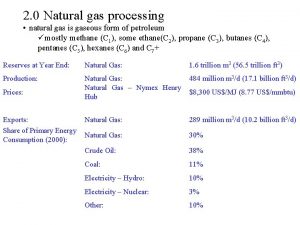NATURAL GAS Natural gas consisting mostly of methane




























































































- Slides: 92

NATURAL GAS • Natural gas, consisting mostly of methane, is often found above reservoirs of crude oil. – When a natural gas-field is tapped, gasses are liquefied and removed as liquefied petroleum gas (LPG). • Coal beds and bubbles of methane trapped in ice crystals deep under the arctic permafrost and beneath deep-ocean sediments are unconventional sources of natural gas.

NATURAL GAS • Russia and Iran have almost half of the world’s reserves of conventional gas, and global reserves should last 62 -125 years. • Natural gas is versatile and clean-burning fuel, but it releases the greenhouse gases carbon dioxide (when burned) and methane (from leaks) into the troposphere.

COAL • Coal is a solid fossil fuel that is formed in several stages as the buried remains of land plants that lived 300 -400 million years ago. Figure 16 -12

Increasing heat and carbon content Increasing moisture content Peat (not a coal) Lignite (brown coal) Bituminous (soft coal) Anthracite (hard coal) Heat Pressure Partially decayed plant matter in swamps and bogs; low heat content Low heat content; low sulfur content; limited supplies in most areas Extensively used as a fuel because of its high heat content and large supplies; normally has a high sulfur content Highly desirable fuel because of its high heat content and low sulfur content; supplies are limited in most areas Fig. 16 -12, p. 368

Waste heat Coal bunker Cooling tower transfers waste heat to atmosphere Turbine Generator Cooling loop Stack Pulverizing mill Condenser Filter Boiler Toxic ash disposal Fig. 16 -13, p. 369

COAL • Coal reserves in the United States, Russia, and China could last hundreds to over a thousand years. – The U. S. has 27% of the world’s proven coal reserves, followed by Russia (17%), and China (13%). – In 2005, China and the U. S. accounted for 53% of the global consumption.

TYPES OF ENERGY RESOURCES • About 99% of the energy we use for heat comes from the sun and the other 1% comes mostly from burning fossil fuels. – Solar energy indirectly supports wind power, hydropower, and biomass. • About 76% of the commercial energy we use comes from nonrenewable fossil fuels (oil, natural gas, and coal) with the remainder coming from renewable sources.

TYPES OF ENERGY RESOURCES • Nonrenewable energy resources and geothermal energy in the earth’s crust. Figure 16 -2

Oil and natural gas Floating oil drilling platform Oil drilling platform on legs Gas well Oil storage Oil well Pipeline Valves Pump Imper vious rock N a Oil tural ga s Water Coal seam Mined coal Coal Geothermal Contour energy strip mining Hot water storage Geothermal power plant Area strip mining Pipeline Under gr coal m ound ine Water i brougs heated a steam ht up as nd or we d t stea ry m Hot ro ck Magm a Drilling tower Water penetrates down through the rock Fig. 16 -2, p. 357

TYPES OF ENERGY RESOURCES • Commercial energy use by source for the world (left) and the U. S. (right). Figure 16 -3

REDUCING ENERGY WASTE AND IMPROVING ENERGY EFFICIENCY • Four widely used devices waste large amounts of energy: – Incandescent light bulb: 95% is lost as heat. – Internal combustion engine: 94% of the energy in its fuel is wasted. – Nuclear power plant: 92% of energy is wasted through nuclear fuel and energy needed for waste management. – Coal-burning power plant: 66% of the energy released by burning coal is lost.

USING RENEWABLE SOLAR ENERGY TO PROVIDE HEAT AND ELECTRICITY • A variety of renewable-energy resources are available but their use has been hindered by a lack of government support compared to nonrenewable fossil fuels and nuclear power. – Direct solar – Moving water – Wind – Geothermal

USING RENEWABLE SOLAR ENERGY TO PROVIDE HEAT AND ELECTRICITY • The European Union aims to get 22% of its electricity from renewable energy by 2010. • Costa Rica gets 92% of its energy from renewable resources. • China aims to get 10% of its total energy from renewable resources by 2020. • In 2004, California got about 12% of its electricity from wind and plans to increase this to 50% by 2030.

USING RENEWABLE SOLAR ENERGY TO PROVIDE HEAT AND ELECTRICITY • Denmark now gets 20% of its electricity from wind and plans to increase this to 50% by 2030. • Brazil gets 20% of its gasoline from sugarcane residue. • In 2004, the world’s renewable-energy industries provided 1. 7 million jobs.

Solar • Types – photovoltaic cells (convert sunlight directly to electricity with a 10% efficiency) and solar thermal systems (sun’s heat is used to heat bodies of water enough to produce steam that can be used to make electricity) • Energy conversion – radiant/heat to electrical, heat or mechanical • Benefits – pollution-free, unlimited source • Costs – not useful in cloudy areas or at night, we do not have the technology needed to use very efficiently

Producing Electricity with Solar Cells • Photovoltaic (PV) cells can provide electricity for a house of building using solar-cell roof shingles. Figure 17 -17

Single solar cell Solar-cell roof – + Boron enriched silicon Roof options Junction Phosphorus enriched silicon Panels of solar cells Solar shingles Fig. 17 -17, p. 398

Producing Electricity with Solar Cells • Solar cells can be used in rural villages with ample sunlight who are not connected to an electrical grid. Figure 17 -18

Core Case Study: The Coming Energy. Efficiency and Renewable-Energy Revolution • It is possible to get electricity from solar cells that convert sunlight into electricity. – Can be attached like shingles on a roof. – Can be applied to window glass as a coating. – Can be mounted on racks almost anywhere.

Core Case Study: The Coming Energy. Efficiency and Renewable-Energy Revolution • The heating bill for this energy-efficient passive solar radiation office in Colorado is $50 a year. Figure 17 -1


Passive Solar Heating • Passive solar heating system absorbs and stores heat from the sun directly within a structure without the need for pumps to distribute the heat. Figure 17 -13

Direct Gain Ceiling and north wall heavily insulated Summer sun Hot air Warm air Superinsulated windows Winter sun Cool air Earth tubes Fig. 17 -13, p. 396

Greenhouse, Sunspace, or Attached Solarium Summer cooling vent Warm air Insulated windows Cool air Fig. 17 -13, p. 396

Earth Sheltered Earth Reinforced concrete, carefully waterproofed walls and roof Triple-paned or superwindows Flagstone floor for heat storage Fig. 17 -13, p. 396

Trade-Offs Passive or Active Solar Heating Advantages Disadvantages Energy is free Need access to sun 60% of time Net energy is moderate (active) to high (passive) Quick installation No CO 2 emissions Sun blocked by other structures Need heat storage system Very low air and water pollution High cost (active) Very low land disturbance (built into roof or window) Active system needs maintenance and repair Moderate cost (passive) Active collectors unattractive Fig. 17 -14, p. 396

Cooling Houses Naturally • We can cool houses by: – Superinsulating them. – Taking advantages of breezes. – Shading them. – Having light colored or green roofs. – Using geothermal cooling.

Wind • Energy conversion – kinetic to electrical • Benefits – pollution-free, source is free (used in West Texas, Hawaii, California, and more) • Costs – can only be used in places with lots of wind

PRODUCING ELECTRICITY FROM WIND • Wind power is the world’s most promising energy resource because it is abundant, inexhaustible, widely distributed, cheap, clean, and emits no greenhouse gases. • Much of the world’s potential for wind power remains untapped. • Capturing only 20% of the wind energy at the world’s best energy sites could meet all the world’s energy demands.

PRODUCING ELECTRICITY FROM WIND • Wind turbines can be used individually to produce electricity. They are also used interconnected in arrays on wind farms. Figure 17 -21

PRODUCING ELECTRICITY FROM WIND • The United States once led the wind power industry, but Europe now leads this rapidly growing business. – The U. S. government lacked subsidies, tax breaks and other financial incentives. • European companies manufacture 80% of the wind turbines sold in the global market – The success has been aided by strong government subsidies.




Biomass • Description – any type of organic matter (forest products, crop wastes, animal wastes, people wastes, etc. ) that can be used to produce energy; currently used for about 5% of U. S. energy • Energy conversion – chemical to electrical or heat • Benefits – cheap, less toxic pollutants, using wastes effectively, currently used in Rio Grande Valley with the burning of sugar cane residue, also produces food, feed, and fiber • Costs – we don’t have all the technology needed to use this well right now, not useful in every location, some pollution is produced

PRODUCING ENERGY FROM BIOMASS • Plant materials and animal wastes can be burned to provide heat or electricity or converted into gaseous or liquid biofuels. Figure 17 -23

PRODUCING ENERGY FROM BIOMASS • The scarcity of fuelwood causes people to make fuel briquettes from cow dung in India. This deprives soil of plant nutrients. Figure 17 -24

Trade-Offs Solid Biomass Advantages Disadvantages Large potential supply in some areas Nonrenewable if harvested unsustainably Moderate costs Moderate to high environmental impact No net CO 2 increase if harvested and burned sustainably CO 2 emissions if harvested and burned unsustainably Plantation can be located on semiarid land not needed for crops Low photosynthetic efficiency Soil erosion, water pollution, and loss of wildlife habitat Plantation can help restore degraded lands Plantations could compete with cropland Can make use of agricultural, timber, and urban wastes Often burned in inefficient and polluting open fires and stoves Fig. 17 -25, p. 405

Water • Energy conversion – kinetic to electrical or heat • Benefits – already have the technology to do this, pollution free, dams are also useful as water sources and flood controls; world’s largest source of electrical power • Costs – there are environmental costs to building new dams, there are not rivers located everywhere • Read James Bay Watershed Transfer Project Miller Page 304

PRODUCING ELECTRICITY FROM THE WATER CYCLE • Water flowing in rivers and streams can be trapped in reservoirs behind dams and released as needed to spin turbines and produce electricity. • There is little room for expansion in the U. S. – Dams and reservoirs have been created on 98% of suitable rivers.

Trade-Offs Large-Scale Hydropower Advantages Disadvantages Moderate to high net energy High construction costs High efficiency (80%) High environmental impact from flooding land to form a reservoir Large untapped potential Low-cost electricity Long life span No CO 2 emissions during operation in temperate areas High CO 2 emissions from biomass decay in shallow tropical reservoirs Floods natural areas behind dam Converts land habitat to lake habitat May provide flood control below dam Danger of collapse Provides water for year-round irrigation of cropland Decreases fish harvest below dam Reservoir is useful for fishing and recreation Uproots people Decreases flow of natural fertilizer (silt) to land below dam Fig. 17 -20, p. 400

Geothermal • Description – heat from deep within the earth is used to produce electricity • This is the only energy source that doesn’t come from the sun! • Energy conversion – thermal to electrical and heat • Benefits – pollution-free, used near Waco and in Iceland • Costs – not available everywhere, we don’t have all the technology needed to use it

GEOTHERMAL ENERGY • Geothermal energy consists of heat stored in soil, underground rocks, and fluids in the earth’s mantle. • We can use geothermal energy stored in the earth’s mantle to heat and cool buildings and to produce electricity. – A geothermal heat pump (GHP) can heat and cool a house by exploiting the difference between the earth’s surface and underground temperatures.

Geothermal Heat Pump • The house is heated in the winter by transferring heat from the ground into the house. • The process is reversed in the summer to cool the house. Figure 17 -31



Tidal Power • Energy conversion – kinetic to electrical • Benefits – pollution-free, cheap, renewable • Costs – only two places in the U. S. have tides needed to do this


Wave Power • Energy conversion – kinetic to electrical • Benefits – pollution-free, cheap, renewable • Costs - only suitable in areas facing the open ocean (especially on the West Coasts of continents); tend to be destroyed in storms

PRODUCING ELECTRICITY FROM THE WATER CYCLE • Ocean tides and waves and temperature differences between surface and bottom waters in tropical waters are not expected to provide much of the world’s electrical needs. • Only two large tidal energy dams are currently operating: one in La Rance, France and Nova Scotia’s bay of Fundy where the tidal amplitude can be as high as 16 meters (63 feet).


NUCLEAR ENERGY • When isotopes of uranium and plutonium undergo controlled nuclear fission, the resulting heat produces steam that spins turbines to generate electricity. – The uranium oxide consists of about 97% nonfissionable uranium-238 and 3% fissionable uranium-235. – The concentration of uranium-235 is increased through an enrichment process.

Small amounts of radioactive gases Uranium fuel Control rods input (reactor Containment shell core) Heat exchanger Turbine Steam Generator Waste heat Hot coolant Hot water Pump output Pump Coolant Pump Moderator Shielding Coolant Pressure passage vessel Periodic removal and storage of radioactive wastes and spent fuel assemblies Water Periodic removal and storage of radioactive liquid wastes Pump Cool water input Electric power Useful energy 25%– 30% Waste heat Condenser Water source (river, lake, ocean) Fig. 16 -16, p. 372

NUCLEAR ENERGY • After three or four years in a reactor, spent fuel rods are removed and stored in a deep pool of water contained in a steel -lined concrete container. Figure 16 -17

NUCLEAR ENERGY • After spent fuel rods are cooled considerably, they are sometimes moved to dry-storage containers made of steel or concrete. Figure 16 -17

What Happened to Nuclear Power? • After more than 50 years of development and enormous government subsidies, nuclear power has not lived up to its promise because: – Multi billion-dollar construction costs. – Higher operation costs and more malfunctions than expected. – Poor management. – Public concerns about safety and stricter government safety regulations.

Case Study: The Chernobyl Nuclear Power Plant Accident • The world’s worst nuclear power plant accident occurred in 1986 in Ukraine. • The disaster was caused by poor reactor design and human error. • By 2005, 56 people had died from radiation released. – 4, 000 more are expected from thyroid cancer and leukemia.

NUCLEAR ENERGY • A 1, 000 megawatt nuclear plant is refueled once a year, whereas a coal plant requires 80 rail cars a day. Figure 16 -20

Trade-Offs Coal vs. Nuclear Coal Nuclear Ample supply of uranium High net energy yield Low net energy yield Very high air pollution Low air pollution (mostly from fuel reprocessing) High CO 2 emissions Low CO 2 emissions (mostly from fuel reprocessing) High land disruption from surface mining Much lower land disruption from surface mining High land use Moderate land use Low cost (with huge subsidies) High cost (even with huge subsidies) Fig. 16 -20, p. 376

NUCLEAR ENERGY • Terrorists could attack nuclear power plants, especially poorly protected pools and casks that store spent nuclear fuel rods. • Terrorists could wrap explosives around small amounts of radioactive materials that are fairly easy to get, detonate such bombs, and contaminate large areas for decades.

NUCLEAR ENERGY • When a nuclear reactor reaches the end of its useful life, its highly radioactive materials must be kept from reaching the environment for thousands of years. • At least 228 large commercial reactors worldwide (20 in the U. S. ) are scheduled for retirement by 2012. – Many reactors are applying to extent their 40 year license to 60 years. – Aging reactors are subject to embrittlement and corrosion.

NUCLEAR ENERGY • Building more nuclear power plants will not lessen dependence on imported oil and will not reduce CO 2 emissions as much as other alternatives. – The nuclear fuel cycle contributes to CO 2 emissions. – Wind turbines, solar cells, geothermal energy, and hydrogen contributes much less to CO 2 emissions.

NUCLEAR ENERGY • Scientists disagree about the best methods for long-term storage of high-level radioactive waste: – Bury it deep underground. – Shoot it into space. – Bury it in the Antarctic ice sheet. – Bury it in the deep-ocean floor that is geologically stable. – Change it into harmless or less harmful isotopes.

Nuclear • Description – using fission to split large uranium atoms into smaller products and releasing tremendous amounts of heat energy which is used to make steam that turns turbines to create electricity • Energy conversion – nuclear to electrical and heat • Benefits – pollution-free, very efficient • Costs – risk of accidents (spread of radioactivity); transportation and disposal of radioactive wastes (Nimby!) It also produces a ton of thermal pollution!

WAYS TO IMPROVE ENERGY EFFICIENCY • We can save energy in building by getting heat from the sun, superinsulating them, and using plant covered green roofs. • We can save energy in existing buildings by insulating them, plugging leaks, and using energyefficient heating and cooling systems, appliances, and lighting.

Strawbale House • Strawbale is a superinsulator that is made from bales of low-cost straw covered with plaster or adobe. Depending on the thickness of the bales, its strength exceeds standard construction. Figure 17 -9

Living Roofs • Roofs covered with plants have been used for decades in Europe and Iceland. • These roofs are built from a blend of light-weight compost, mulch and sponge-like materials that hold water. Figure 17 -10

Saving Energy in Existing Buildings • About one-third of the heated air in typical U. S. homes and buildings escapes through closed windows and holes and cracks. Figure 17 -11

Approximate Energy Efficiencies: • Photosynthesis: 1% • Incandescent light bulbs: 95%

Alternative Fuels Definition • Any fuel that meets certain emissions standards; i. e. they give off a certain amount of pollution (or less)

Laws Involved • Clean Air Act amendments of 1990 • Energy Policy Act (EPACT) in Texas of 1992 • Such laws have led to more research and development of these fuels

Examples of Alternative Fuels • Biodiesel – made of vegetable oils and alcohols; expensive • Diesel – cleaner than “normal” gasoline, being more refined • Biogas – by-product of decaying vegetation; need technology • Hydrogen – expensive and we need more technology

n. Ethanol/Methanol – alcohols; not as efficient (Miles per gallon) and we don’t have all the technology ; also, if our grain supplies are used to make fuel, will we have enough to feed the world? n. Natural Gas – expensive and we need more technology n. Reformulated Gasoline (RFG) – regular gas that has been further refined to remove some of the more toxic pollutants

n. Propane – most usable form of alternative fuel; not as efficient (mpg) n. Syngas – manmade gas made of hydrogen and carbon monoxide; need more technology to use it

HYDROGEN • Some energy experts view hydrogen gas as the best fuel to replace oil during the last half of the century, but there are several hurdles to overcome: – Hydrogen is chemically locked up in water an organic compounds. – It takes energy and money to produce it (net energy is low). – Fuel cells are expensive. – Hydrogen may be produced by using fossil fuels.

Energy Laws • Public Utility Holding Company Act (PUHCA) – 1935; regulated the interstate flow of energy; 1 st law of its kind; a law designed to protect consumers from corporate abuse of electricity markets • (so electric companies can’t price gouge. ) This was happening during the great depression.

n. Corporate Average Fuel Economy Act (CAFÉ) – 1975; focused attention on efficiency of cars; mpg stickers required n. Public Utility Regulatory Policies Act (PURPA)– 1978; higher utility rates for increased electricity use

Converting Plants and Plant Wastes to Liquid Biofuels: An Overview • Motor vehicles can run on ethanol, biodiesel, and methanol produced from plants and plant wastes. • The major advantages of biofuels are: – Crops used for production can be grown almost anywhere. – There is no net increase in CO 2 emissions. – Widely available and easy to store and transport.

Case Study: Producing Ethanol n Switchgrass can remove CO 2 from the troposphere and store it in the soil. • Crops such as sugarcane, corn, and switchgrass and agricultural, forestry and municipal wastes can be converted to ethanol. Figure 17 -26

Case Study: Producing Ethanol • 10 -23% pure ethanol makes gasohol which can be run in conventional motors. • 85% ethanol (E 85) must be burned in flex-fuel cars. • Processing all corn grown in the U. S. into ethanol would cover only about 55 days of current driving. • Biodiesel is made by combining alcohol with vegetable oil made from a variety of different plants. .

Case Study: Biodiesel and Methanol • Growing crops for biodiesel could potentially promote deforestation. • Methanol is made mostly from natural gas but can also be produced at a higher cost from CO 2 from the atmosphere which could help slow global warming. – Can also be converted to other hydrocarbons to produce chemicals that are now made from petroleum and natural gas.

WAYS TO IMPROVE ENERGY EFFICIENCY • Average fuel economy of new vehicles sold in the U. S. between 1975 -2006. • The government Corporate Average Fuel Economy (CAFE) has not increased after 1985. Figure 17 -5

Average fuel economy (miles per gallon, or mpg) Cars Both Pickups, vans, and sport utility vehicles Model year Fig. 17 -5, p. 388

WAYS TO IMPROVE ENERGY EFFICIENCY • General features of a car powered by a hybrid-electric engine. • “Gas sipping” cars account for less than 1% of all new car sales in the U. S. Figure 17 -7

Regulator: Controls flow of power between electric motor and battery bank. Transmission: Efficient 5 -speed automatic transmission. Fuel tank: Liquid fuel such as gasoline, diesel, or ethanol runs small combustion engine. Battery: High-density battery powers electric motor for increased power. Combustion engine: Small, efficient internal combustion engine powers vehicle with low emmissions; shuts off at low speeds and stops. Fuel Electric motor: Traction drive provides additional power for passing and acceleration; excess energy recovered during braking is used to help power motor. Electricity Fig. 17 -7, p. 389

Hybrid Vehicles, Sustainable Wind Power, and Oil imports • Hybrid gasoline-electric engines with an extra plug-in battery could be powered mostly by electricity produced by wind and get twice the mileage of current hybrid cars. – Currently plug-in batteries would by generated by coal and nuclear power plants. – According to U. S. Department of Energy, a network of wind farms in just four states could meet all U. S. electricity means.

Fuel-Cell Vehicles • Fuel-efficient vehicles powered by a fuel cell that runs on hydrogen gas are being developed. • Combines hydrogen gas (H 2) and oxygen gas (O 2) fuel to produce electricity and water vapor (2 H 2+O 2 2 H 2 O). • Emits no air pollution or CO 2 if the hydrogen is produced from renewable-energy sources.

Air system management Fuel-cell stack Converts hydrogen fuel into electricity Body attachments Universal docking connection Mechanical locks that secure the Connects the chassis with the body to the chassis drive-by-wire system in the body Rear crush zone Absorbs crash energy Drive-by-wire system controls Cabin heating unit Hydrogen fuel tanks Side-mounted radiators Release heat generated by the fuel cell, vehicle electronics, and wheel motors Front crush zone Absorbs crash energy Electric wheel motors Provide four-wheel drive; have built-in brakes Fig. 17 -8, p. 390


n. National Appliance Energy Act – 1987; energy efficiency stickers on all appliances

• Renewable Energy and Technology Competitiveness Act – 1989; effort to develop renewable energy nationally • Clean Air Act Amendments – 1990; set standards for cities and emissions • Energy Policy Act – 1992; comprehensive effort to find renewable energy resources

n. Hydrogen Future Act – 1996; develop hydrogen as an energy source n. PROBLEM – FEW of these actually provide the money needed to research renewable resources
 Incomplete combustion of propane
Incomplete combustion of propane Methane gas
Methane gas Methane hydrate definition
Methane hydrate definition Global methane budget
Global methane budget Molar volume of methane
Molar volume of methane Production of hydrogen from methane
Production of hydrogen from methane Methane oxidation
Methane oxidation Vache methane
Vache methane Methane ethane
Methane ethane Jdm jesip
Jdm jesip Lithium fluoride bohr diagram
Lithium fluoride bohr diagram Methane oxygen endothermic or exothermic
Methane oxygen endothermic or exothermic Porphyrin
Porphyrin Global methane budget 2020 upsc
Global methane budget 2020 upsc Is methane lighter than air
Is methane lighter than air Methane oxidation
Methane oxidation Markinikov
Markinikov Saturated vs unsaturated fat
Saturated vs unsaturated fat Condensed structural formula of alkenes
Condensed structural formula of alkenes Methane and water
Methane and water Tertiary treatment apes
Tertiary treatment apes Complete outer shell
Complete outer shell Methane covalent bond
Methane covalent bond What is monochlorination
What is monochlorination Methane oxidation
Methane oxidation Ethane methane propane butane
Ethane methane propane butane Combustion of methane
Combustion of methane Reponses
Reponses Neptune uranus
Neptune uranus Initial response phase of a major incident
Initial response phase of a major incident Chemistry symbols in equations
Chemistry symbols in equations Chemical reaction combustion
Chemical reaction combustion Methane classification
Methane classification Hydrogen production technologies ppt
Hydrogen production technologies ppt Schema lie lse
Schema lie lse In the figure ba and bc are opposite rays bh bisects ebc
In the figure ba and bc are opposite rays bh bisects ebc Logotheray
Logotheray In-memory file system
In-memory file system Beam loaded as shown in fig. p-428
Beam loaded as shown in fig. p-428 An artificial cell consisting of an aqueous solution
An artificial cell consisting of an aqueous solution Ap psychology intelligence test
Ap psychology intelligence test Tools and equipment
Tools and equipment 14 line poem written in iambic pentameter
14 line poem written in iambic pentameter Lines ab and cg are
Lines ab and cg are A petty cash fund is always replenished ____.
A petty cash fund is always replenished ____. What is digestive system
What is digestive system Comical entertainment industry
Comical entertainment industry Mostly unicellular
Mostly unicellular Concealed puncture wounds meaning
Concealed puncture wounds meaning Strata are mostly found brainpop quizlet
Strata are mostly found brainpop quizlet 9 planets
9 planets A program designed to send your advertisements, pop-ups
A program designed to send your advertisements, pop-ups We are usually referring to species diversity
We are usually referring to species diversity Xamarin mostly using mvvm paradigm
Xamarin mostly using mvvm paradigm Russia's climate is mostly _____.
Russia's climate is mostly _____. What the text is mostly about
What the text is mostly about Mostly fun
Mostly fun Circular metal percussion instruments phrase or clause
Circular metal percussion instruments phrase or clause The bubbles released by elodea contain mostly
The bubbles released by elodea contain mostly Mixed media collage definition
Mixed media collage definition The sun is made mostly of
The sun is made mostly of Horace and morris but mostly dolores
Horace and morris but mostly dolores Bus, ring and star topologies mostly used in the
Bus, ring and star topologies mostly used in the Where can we mostly asteroid found
Where can we mostly asteroid found The members of the counterculture movement were mostly
The members of the counterculture movement were mostly Hellmin
Hellmin Where is buddhism mostly located
Where is buddhism mostly located Conclusion on bhopal gas tragedy
Conclusion on bhopal gas tragedy Gas exchange key events in gas exchange
Gas exchange key events in gas exchange An ideal gas is an imaginary gas
An ideal gas is an imaginary gas Poisonous gas leaked in bhopal gas tragedy
Poisonous gas leaked in bhopal gas tragedy Gas leaked in bhopal gas tragedy
Gas leaked in bhopal gas tragedy Differences between ideal gas and real gas
Differences between ideal gas and real gas Difference between ideal gas and real gas
Difference between ideal gas and real gas Gas reale e gas ideale
Gas reale e gas ideale Computational fluid dynamics
Computational fluid dynamics Flue gas desulfurisation gas filter
Flue gas desulfurisation gas filter Reaksi pembentukan gas no2f dari gas no2 dan f2
Reaksi pembentukan gas no2f dari gas no2 dan f2 Ideal gas vs perfect gas
Ideal gas vs perfect gas Advantages and disadvantages of nonrenewable energy
Advantages and disadvantages of nonrenewable energy Odorometer natural gas
Odorometer natural gas Anderson filter
Anderson filter Offshore drilling
Offshore drilling Greenhouse impact
Greenhouse impact Renovagas
Renovagas Pros and cons
Pros and cons Información sobre el gas natural
Información sobre el gas natural How natural gas is formed
How natural gas is formed Fracking natural gas
Fracking natural gas Gás natural
Gás natural Habilitacion gas natural
Habilitacion gas natural Petroleum and natural gas formation
Petroleum and natural gas formation Natural gas advantages
Natural gas advantages
